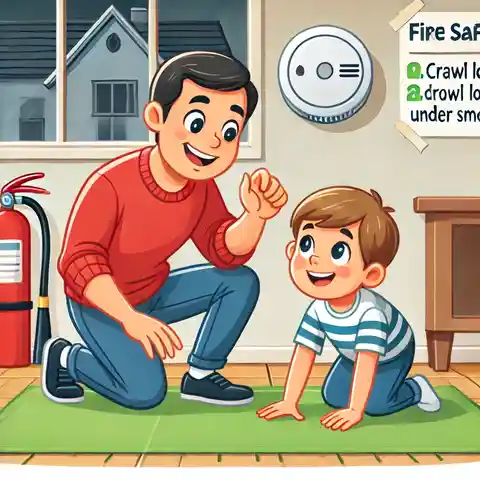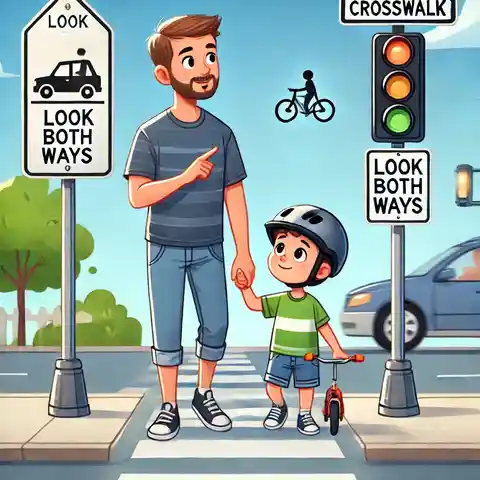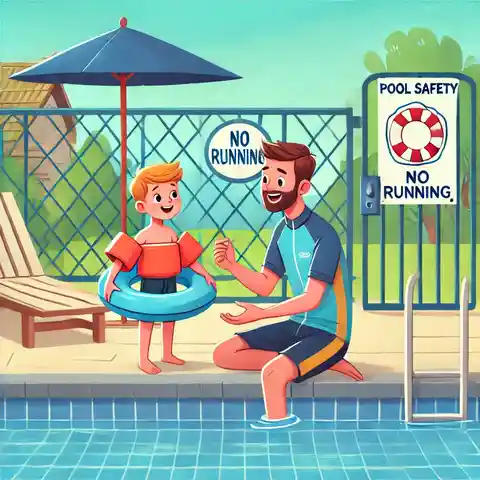Teaching children safety: As they grow, kids love exploring with their eyes wide open; it all seems so exciting. By teaching safety at a young age, we can help them learn how to keep themselves and others safe. Knowing safety rules helps kids feel confident and deal with different situations.
Meanwhile, this post has some essential safety tips for kids (and so advice to give parents on teaching these lessons), and last but not least, an unrelated poll! Introducing safety education at an early age uses basic principles and builds that foundation to encourage kids to become safe children — then adults.
The Value of Safety Teaching
Children are curious and naturally love to explore the world. But on other occasions, this curiosity can turn dangerous, too. Helping to keep them safe is more than just preventing accidents—it’s teaching them safety. Children should be able to understand safety and how it can affect dangerous and risky situations. That way, they become safe and confident adults, much to the relief of their parents.
Critical Areas of Safety to Teach Children
Top safety tips for kids · what age should your child learn about bullying? How much sleep does my baby need?
1. Personal Safety

It is essential to teach your kids personal safety. Here are some key points:
Stranger Danger: Make sure the kids mind people they do not recognize. Explain to them that they should never go anywhere with a stranger. Ensure they understand that people should say “no” and find a grown-up if someone makes them feel scared or uncomfortable.
Knowing Contact Information: Kids should know their full name, parent’s names, address, and phone number. Make them remember and practice this with the.
Body Safety—Let kids know their bodies are theirs, and if someone touches them in a way that makes them feel icky, they can say no. Educate them on safe and unsafe touches and encourage them to inform a responsible adult if they are ever concerned.
2. Road Safety

Father and son at the corner of buoy 10 in Astoria. [/caption]
Kids walking, biking, or riding in a car need to know how to stay safe and be responsible on the road. Here are some key points:
- Crossing the Street: Ensure to practice crosswalks where available and teach kids to make eye contact with drivers so they can be seen.
- Wear Helmets: As kids start riding bikes, skateboarding, roller skates, etc., there are constant reminders that they should be accompanied by helmets. They wear helmets to protect their brains if they happen to fall.
- Car Safety: For kids 2 years or older, make sure they use a car seat or booster seat that is the best choice for their age.
3. Fire Safety

Fire safety is a significant concern because fires can start suddenly and spread quickly. Here are some key points:
- Stop, drop, and roll: Children should be taught that if their clothes catch on fire, they are to stop where they are and fall onto the ground or floor immediately in order not to prevent forward motion from turning off further progress of the body tissues, which will result become pyrophoric combusting tissue decomposition, then ROLL TO PUT OUT THE FIRE. Perform this with them so that they remember.
- Smoke Alarms: What they do and sound like—instruct children to leave immediately if they hear a smoke alarm and never return inside.
- Fire Drills: They even practice fire drills at home. Everyone knows where to go and how to get out quickly. Designate a meeting point outside of the home where everyone should meet.
4. Water Safety

Drowning prevention is critical for water safety, especially with pools and bodies of water. Here are some key points:
- Supervision: Never leave children near any body of water, whether a pool, bath, or lake. They should always be under adult supervision.
- Swimming Lessons: Get your children into swimming lessons so they learn how to swim and make sure it is done safely. Swimming Educates In Drowning Prevention And Develops Confidence
- Pool safety: If you have a pool, be sure it is surrounded by a fence with a locked gate. Teach kids not to run around the pool and only gently push or dunk.
5. Online Safety

For those of you who live in a cave, online safety is quite rightly a hot topic for kids growing up in today’s digital world. Key points include:
- Safe Browsing: Teach kids to use the internet safely by only opening websites and apps approved for them. Should you use the Internet to talk about anything personal?
- Cyberbullying: Be sure to have teaching moments with kids on why it’s important to be nice when online and what they should do if someone is bullying them or another person. Tell them to speak out and tell an adult they trust to stop it.
- Use privacy settings: Teach children how to use their online devices, including social media and smartphones. You can also teach them to keep their profiles private and only accept friend requests from people they know.
6. Home Safety
Home safety is an important part — helping kids learn how to stay safe in and around the house. Key points include:
- Emergency Numbers: Children should know how to dial emergency numbers, like 911, and what qualifies as an appropriate time/case when they need help. They need practice with these scenarios to know what to say in an emergency.
- Unsafe Situations in the House: Teach safety measures for dangerous situations like knives, cleansers, and hot ovens. Ensure children learn to ask for help if they want something from a high shelf or need an item they deem too dangerous.
- Designated Play Areas: Create a designated play area for children that is child-safe and free from harm, such as sharp corners, breakable items, or electrical outlets.
7. School Safety
It teaches children how to be safe on school grounds and at school activities. Key points include:
- Bus Safety: Instruct your children how to get on and off the bus safely and remind them to stay seated when it is moving.
- Playground Rules: Review the rules of playground safety (e.g., waiting their turn, not punching or shoving, and using equipment as intended).
- Walking to School: Especially if your kids walk, teach them how and when it is appropriate to use crosswalks, obey traffic signals, and never accept rides from strangers.
8. Stranger Safety
Stranger safety is about enabling kids to identify and avoid possibly unhealthy interactions with strangers. Key points include:
- Teaching Children to Recognize Safe Adults: Tell children about safe strangers, like police officers or teachers.
- Code Words: Set a code word for the family that only trusted adults know. How: Tell your kids to use this code word if a stranger offers them to be taken or picked up from somewhere in their absence.
- Keep Distance: Maintain a safe distance and teach your child not to accept gifts, rides, or food from strangers.
9. Animal Safety
Teach Children How To Be Safe Around Animalsikanago/ShutterstockAnimals are another thing that poses a risk when it comes to afternoon activities during the summer. Key points include:
- Available to You: Educate your children never to approach a dog or any animal without permission. Show them to move in calmly and slowly and allow the animal to sniff them first.
- Common Sense: Be sure to tell your kids about the dangers they can find in animals like raccoons, snakes, and stray dogs—instruct children to admire the animals from afar and never reach out to touch or hand food over.
- Recognizing Signs of Aggression: Teach your children to identify when an animal feels aggressive (growling, hissing, raised fur). This way, they can gradually get away and ask an adult for help if they find an aggressive animal.
10. Emergency Preparedness
Therefore, one focus of emergency preparedness is teaching children what to do in different types of emergencies. Key points include:
- Have a Plan: Children need to know where the family emergency plan is, specifically who they should contact in case of a fire, earthquake, or severe weather.
- First, conduct regular practice drills, from fire to earthquake evacuation, so your little ones know what they have to do and where they need to go.
- How to stay calm: Children must be taught the significance of composure in panic. They should be encouraged to breathe deeply and put their safety plan into action.
Teaching Kids Safety: FAQs Answered
- At what age is it best for children to learn about safety?
Teach safety as soon as children begin to explore. Start with simple rules and enforce more as they get older.
- How do we teach our kids about stranger danger and not allow fear to paralyze action?
Be straightforward in your words and encourage feelings you trust. Let them know that they can always say “no” if anything or anyone makes them feel uncomfortable and to go to an adult they trust.
- How can kids learn road safety?
While learning, play games, sing songs, and listen to stories. Go on walks, and always remember to stop at the corner line and look both ways.
- How do I help my child remember emergency contact information?
Repeat the information. And repeat and repeat it. TURN IT INTO A SONG(S). Play a game with flashcards of your address, phone number, and parents’ names to help them remember where they live.
- How can you teach fire safety at home?
Hold fire drills in the home, teach children about smoke alarms, and teach them how to ‘stop drop roll’. They need to know how to exit the house safely and where they should meet outside.
- how do I ensure my child stays safe digitally?
Teach them how to be safe online and establish rules about the internet. Demonstrate privacy settings and remind your child not to share private information. Continue to talk about it with them.
- What do I tell my child about safe adults?
Itemize the teachers, police officers, and family and friends who are safe adults. Describe why these individuals can be trusted, and push them as someone your child should seek out when experiencing a problem.
- How Do We Turn Preparedness Into Fun for Children?
Transform drills to make them feel like games, create a family emergency kit in a fun way, or present emergencies as stories and videos.
- How do you teach your child appropriate precautions without making them paranoid?
Teach Your Child How To Choose Wisely Use positive language, like explaining that following safety rules makes them stay happy and safe.
Safety education is critical to children’s development. There are tips to keep kids safe in many situations, and parents can teach them by having conversations about different safety topics.
Every safety lesson empowers children to make wise decisions, recognize hazards, and feel confident that they are taking the right actions.
A safe place for kids to grow and learn Safety lessons that begin at an early age will result in a safer environment where the behavior has become so habitual that kids do it without thinking.


